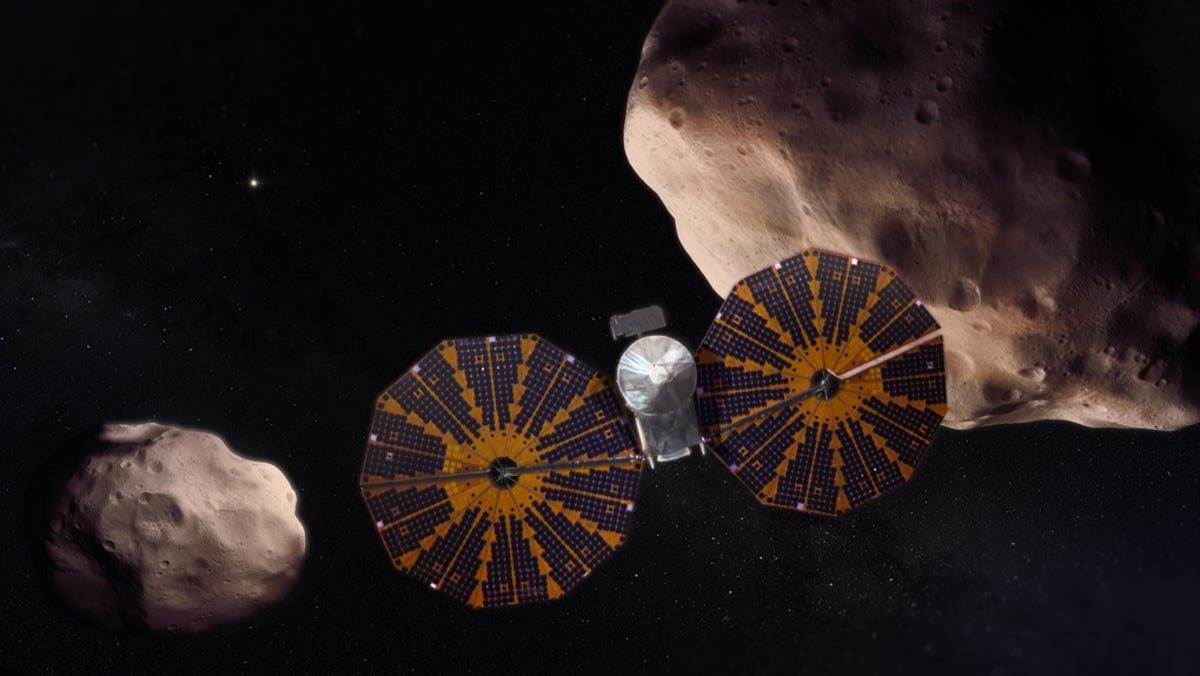NASA reports 'significant progress' in rescuing Lucy asteroid spacecraft's solar array
The near-fully deployed array should 'successfully meet the mission’s needs.'

A stubborn solar array on the NASA Lucy mission might yield enough to allow the mission to continue its asteroid-hunting mandate with few issues, NASA reports.
The agency said it has made "significant progress" in dealing with a solar array on the Lucy mission that failed to fully deploy after the spacecraft's launch, which took place in October 2021. Engineers have been troubleshooting the matter for months.
Lucy has two near-circular solar arrays that are each 24 feet (7 meters) across and designed to unfold like a fan. The arrays are crucial in providing power to the mission, but one of the arrays faced an issue in deployment. An update in January stated that at the time, the second array was a little less than 350 degrees deployed, due to an issue with a lanyard.
Related: Meet the 8 asteroids NASA's Lucy spacecraft will visit
On Thursday (June 28), however, NASA officials stated the Lucy team managed to get the array to between 353 degrees and 357 degrees open. (Full success would be 360 degrees.)
"The array is under substantially more tension, giving it significantly more stabilization," agency officials added in a blog post. "The mission team is increasingly confident the solar array will successfully meet the mission’s needs in its current tensioned and stabilized state."
However, NASA must now pause its efforts to assist Lucy because the spacecraft is moving into a location where it cannot easily receive commands from its humans back on Earth.
Get the Space.com Newsletter
Breaking space news, the latest updates on rocket launches, skywatching events and more!
"Due to thermal constraints caused by the relative positions of the Earth, spacecraft and sun, the spacecraft will be unable to communicate with the Earth via its high-gain antenna for several months," NASA officials wrote.
While engineers can stay in contact with Lucy through a low-gain antenna, that transmitter can process less data. Full communications should resume in October, according to NASA. On Oct. 16, Lucy will fly by Earth to pick up speed for its journey to nine Trojan asteroids orbiting the sun at the same distance as Jupiter; the spacecraft will also emerge from the partial blackout at that time.
NASA may attempt to get that tricky solar array further deployed while the spacecraft remains nearby "if deemed necessary," officials wrote in the post.
Lucy successfully completed a trajectory correction maneuver on June 21, NASA noted.
Although the spacecraft receives plenty of power while it is near Earth, the arrays will need to be close to full deployment to generate enough electricity at the orbit of Jupiter, where sunlight is much fainter. The enormous gas giant planet has an average orbital distance of 484 million miles (778 million kilometers) from the sun, roughly five times more distant than Earth is.
Lucy will be the first spacecraft to visit the Trojan asteroids of Jupiter, which orbit the sun ahead of and behind the planet. These little worlds may hold remnants of the early solar system and in turn, provide information about how our neighborhood was formed.
Follow Elizabeth Howell on Twitter @howellspace. Follow us on Twitter @Spacedotcom and on Facebook.
Join our Space Forums to keep talking space on the latest missions, night sky and more! And if you have a news tip, correction or comment, let us know at: community@space.com.

Elizabeth Howell (she/her), Ph.D., was a staff writer in the spaceflight channel between 2022 and 2024 specializing in Canadian space news. She was contributing writer for Space.com for 10 years from 2012 to 2024. Elizabeth's reporting includes multiple exclusives with the White House, leading world coverage about a lost-and-found space tomato on the International Space Station, witnessing five human spaceflight launches on two continents, flying parabolic, working inside a spacesuit, and participating in a simulated Mars mission. Her latest book, "Why Am I Taller?" (ECW Press, 2022) is co-written with astronaut Dave Williams.










